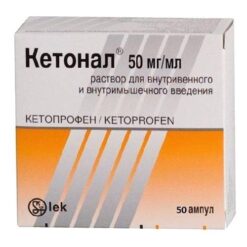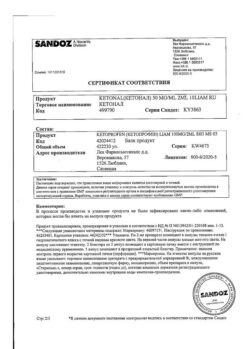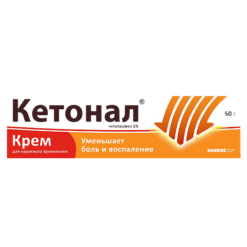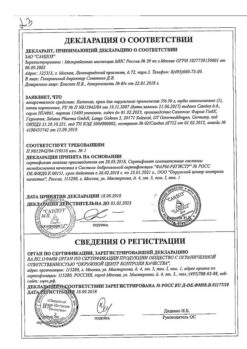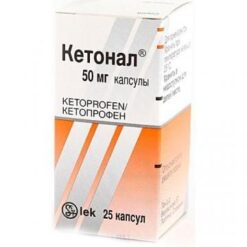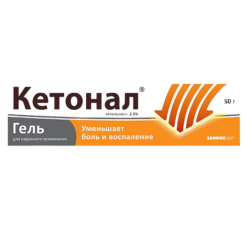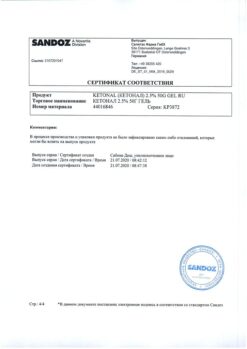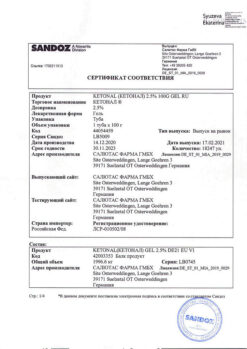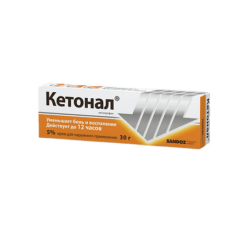No products in the cart.
Ketonal, 50 mg/ml 2 ml 5 pcs
€3.47 €3.08
Description
Pharmacodynamics Ketoprofen is a NSAID with anti-inflammatory, analgesic and antipyretic effects.
By inhibiting COX-1 and -2 and partially lipooxygenase, Ketoprofen inhibits the synthesis of PG and bradykinin and stabilizes lysosomal membranes.
Ketoprofen has no adverse effect on articular cartilage.
Pharmacokinetics
Bioavailability is more than 90%. Binding to plasma proteins – 99%. Cmax of the drug in plasma is reached after 15-30 minutes after parenteral administration. Ketoprofen penetrates into the synovial fluid. Ketoprofen undergoes intensive metabolism through liver microsomal enzymes. It binds to glucuronic acid and is excreted as glucuronide.
Up to 80% of ketoprofen is excreted by the kidneys, mainly (over 90%) in the form of ketoprofen glucuronide, and approximately 10% – through the intestine. Due to the rapid metabolism of ketoprofen its biological T1/2 is less than 2 hours.
Indications
Indications
Symptomatic treatment of painful and inflammatory processes of various origins, including:
Inflammatory and degenerative diseases of the musculoskeletal system:
rheumatoid arthritis,
seronegative arthritis (ankylosing spondylitis / Bechterew’s disease /, psoriatic arthritis, reactive arthritis / Reiter’s syndrome/),
gout, pseudogout,
osteoarthritis.
Pain syndrome:
headache,
tendinitis, bursitis, myalgia, neuralgia, radiculitis,
post-traumatic and postoperative pain syndrome,
algodismenorrhea,
pain syndrome in cancer.
Pharmacological effect
Pharmacological effect
Pharmacodynamics
Ketoprofen is an NSAID with anti-inflammatory, analgesic and antipyretic effects.
Thanks to the inhibition of COX-1 and -2 and partially of lipoxygenase, Ketoprofen suppresses the synthesis of PG and bradykinin, stabilizes lysosomal membranes.
Ketoprofen does not have a negative effect on the condition of articular cartilage.
Pharmacokinetics
Bioavailability – more than 90%. Communication with plasma proteins – 99%. Cmax of the drug in plasma is achieved with parenteral administration after 15–30 minutes. Ketoprofen penetrates into the synovial fluid. Ketoprofen undergoes intensive metabolism via microsomal liver enzymes. It binds to glucuronic acid and is excreted from the body as a glucuronide.
Up to 80% of ketoprofen is excreted by the kidneys, mainly (more than 90%) in the form of ketoprofen glucuronide, and approximately 10% through the intestines. Due to the rapid metabolism of ketoprofen, its biological T1/2 is less than 2 hours.
Special instructions
Special instructions
Ketonal can be washed down with milk or taken with antacids to reduce the frequency of gastrointestinal disorders (milk and antacids do not affect the absorption of ketoprofen).
With long-term use of NSAIDs, it is necessary to monitor the blood condition, as well as liver and kidney function, especially in elderly patients.
Caution must be exercised and blood pressure monitored more often when using ketoprofen to treat patients with arterial hypertension and cardiovascular diseases that lead to fluid retention.
Like other NSAIDs, ketoprofen can mask the symptoms of infectious diseases.
Impact on the ability to drive vehicles and operate machinery
There is no data on the negative effect of Ketonal in recommended doses on the ability to drive a car or operate machinery. At the same time, patients who notice unusual effects when taking the drug Ketonal® should be careful when engaging in potentially hazardous activities that require increased concentration and speed of psychomotor reactions.
Active ingredient
Active ingredient
Ketoprofen
Composition
Composition
1 ampoule contains:
active ingredient: ketoprofen – 100 mg;
excipients:
propylene glycol – 800 mg;
ethanol – 200 mg;
benzyl alcohol – 40 mg;
water for injection – up to 2 ml.
Contraindications
Contraindications
bronchial asthma, rhinitis, history of urticaria caused by taking acetylsalicylic acid or other NSAIDs,
peptic ulcer of the stomach and duodenum in the acute phase,
UC, Crohn’s disease,
hemophilia and other bleeding disorders,
severe liver failure,
severe renal failure,
progressive kidney diseases,
uncompensated heart failure,
postoperative period after coronary artery bypass surgery,
gastrointestinal, cerebrovascular and other bleeding (or suspected bleeding),
chronic dyspepsia,
hypersensitivity to ketoprofen or other components of the drug, as well as salicylates or other NSAIDs.
With caution: the drug should be prescribed for a history of peptic ulcer disease, a history of bronchial asthma, clinically significant cardiovascular, cerebrovascular diseases, peripheral arterial diseases, dyslipidemia, liver failure, hyperbilirubinemia, alcoholic cirrhosis of the liver, renal failure, chronic heart failure, arterial hypertension, blood diseases, dehydration, diabetes mellitus, anamnestic data about the development of ulcerative lesions of the gastrointestinal tract, smoking, concomitant therapy with anticoagulants (for example, warfarin), antiplatelet agents (for example, acetylsalicylic acid), oral corticosteroids (for example, prednisolone), selective serotonin reuptake inhibitors (for example, citalopram, sertraline).
Side Effects
Side Effects
Frequency of occurrence of adverse reactions:
Very common (> 10%).
Common (> 1% but < 10%).
Uncommon (> 0.1%, but < 1%).
Rare (>0.01% but <0.1%).
Very rare (<0.01%).
From the digestive system: common – dyspepsia (nausea, flatulence, diarrhea or constipation, vomiting, decreased or increased appetite), abdominal pain, stomatitis, dry mouth; uncommon (with long-term use in large doses – ulceration of the gastrointestinal mucosa, impaired liver function); rare – perforation of the gastrointestinal tract, exacerbation of Crohn’s disease, melena, bleeding from the gastrointestinal tract, transient increase in the level of liver enzymes.
From the central nervous system and peripheral nervous system: common – headache, dizziness, drowsiness, fatigue, nervousness, nightmares; rare – migraine, peripheral neuropathy; very rare – hallucinations, disorientation, speech disorder.
From the senses: rare – tinnitus, change in taste, blurred vision, conjunctivitis.
From the cardiovascular system: uncommon – tachycardia, arterial hypertension, peripheral edema.
From the hematopoietic system: decreased platelet aggregation; rare – anemia, thrombocytopenia, agranulocytosis, purpura.
From the urinary system: rare – impaired renal function, interstitial nephritis, nephrotic syndrome, hematuria (with long-term use of NSAIDs and diuretics).
Allergic reactions: common – itching, urticaria; uncommon – rhinitis, shortness of breath, bronchospasm, angioedema, anaphylactoid reactions.
Other: rare – hemoptysis, metrorrhagia.
Interaction
Interaction
Ketoprofen reduces the effect of diuretics and antihypertensive drugs.
Enhances the effect of oral hypoglycemic drugs.
Strengthens the effect of some anticonvulsants (for example, phenytoin).
When used simultaneously with other NSAIDs, salicylates, corticosteroids and ethanol, the risk of gastrointestinal bleeding increases.
When used simultaneously with anticoagulants, thrombolytics, and antiplatelet agents, the risk of bleeding increases.
The risk of developing renal dysfunction increases when taken simultaneously with diuretics or ACE inhibitors.
When used simultaneously, it increases the concentration of cardiac glycosides, slow calcium channel blockers, lithium preparations, cyclosporine, methotrexate.
Ketoprofen may reduce the effectiveness of mifepristone. Taking NSAIDs should be started no earlier than 8-12 days after stopping mifepristone.
Overdose
Overdose
Symptoms: vomiting, melena, convulsions, nausea, abdominal pain, vomiting blood, renal failure, impaired consciousness, respiratory depression, impaired renal function.
Treatment: gastric lavage, administration of activated carbon, symptomatic therapy. The use of histamine H2 receptor blockers, prostaglandin inhibitors, and proton pump inhibitors is indicated. There is no specific antidote.
Storage conditions
Storage conditions
At a temperature not exceeding 25 °C
Shelf life
Shelf life
3 years.
Do not use the drug after the expiration date.
Manufacturer
Manufacturer
Lek d.d., Slovenia
Additional information
| Shelf life | 3 years. Do not use the drug after the expiration date. |
|---|---|
| Conditions of storage | At a temperature not exceeding 25 °C |
| Manufacturer | Lek d.d., Slovenia |
| Medication form | solution |
| Brand | Lek d.d. |
Other forms…
Related products
Buy Ketonal, 50 mg/ml 2 ml 5 pcs with delivery to USA, UK, Europe and over 120 other countries.


